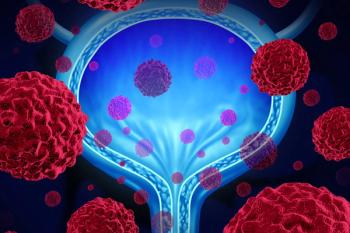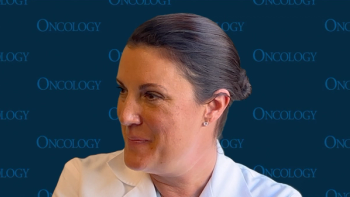
Though TAS-102 Achieved ctDNA Clearance, More Work is Needed
TAS-102 had a significant impact, achieving ctDNA clearance, in patients with colorectal cancer with ctDNA-defined MRD.
In July 2025, results from the phase 2 INTERCEPT-TT trial (NCT05343013) that showed TAS-102 after adjuvant therapy induced circulating tumor DNA (ctDNA) clearance in patients with colorectal cancer (CRC) with ctDNA-defined minimal residual disease (MRD) were published in the Journal of Clinical Oncology.1
Nicholas James Hornstein, MD, PhD, an assistant professor at the Donald and Barbara Zucker School of Medicine of Hofstra University and Northwell Health, and an author of the study, spoke with CancerNetwork® about the results.
At 3 months, 7 (47%) of the 15 eligible patients had negative ctDNA; in the synthetic control arm, 2 patients (7%) spontaneously cleared their ctDNA at 3 months, with both remaining ctDNA-negative at 6 months. Treatment with TAS-102 was associated with an increased rate of ctDNA clearance at 3 months (P = .0034) and 6 months (P = .032).
Further, 9 patients (60%) who received TAS-102 had radiographic recurrence, and 5 (33%) had positive ctDNA but no radiographic evidence of disease in a state of MRD recurrence; in the synthetic control arm, 28 patients (93%) developed radiographic recurrence. The median disease-free survival (DFS) was 9.41 months in the TAS-102 cohort compared with 5.75 months in the synthetic control arm (HR, 0.47; 95% CI, 0.23-0.85; P = .03).
CancerNetwork: Why was this study necessary?
Hornstein: Colorectal cancer is a disease that is way too common. It happens too often in the US, and although we’re getting much better at early detection, [such as] doing colonoscopies and doing screenings, the challenge is that even if we detect it at an early stage, meaning stage II or stage III, we cut it out, and we even give chemotherapy. Up to a third of patients end up having their disease come back in a refractory setting, and the challenge is past conventional polychemotherapy, we don’t have a lot of options, but we’ve developed all these tools now to monitor patients.
ctDNA has the ability for us to look for tiny pieces of DNA from the tumor that might still be present in the bloodstream. They give us this lead time of somewhere between 6 and 9 months of knowing, “Hey, the tumor is probably going to come back, but we don’t have an option for it.” TAS-102, in this setting, was an attempt to see, “Can we change the natural history of the disease if a patient has had all the treatment they’re supposed to get and they’re still ctDNA positive? Can we stop the disease from coming back?” That’s what this study was born out of.
How was this trial designed? Why was a synthetic control arm used?
These were patients who had gone through all their standard of care treatments, whether that was surgery, oligometastatic resection, or chemotherapy. Following that, they’ve completed all the things they’re supposed to do for the standard of care, and yet they still have positive ctDNA. Primarily in the study, there were patients who had oligometastatic CRC who had undergone these resections, so they had no evidence of disease radiographically. They had received their treatments, and then, after all that, had the ctDNA blood test be positive.
The question of why a synthetic cohort is important, it comes down to clinical equipoise. If [there’s] more than a 90% likelihood that your cancer is going to come back, how would you feel if I told you, “Hey, I want you to just wait. We’ll see what happens. Don’t worry about it.” I probably wouldn’t feel very good. The reason we have a synthetic cohort here is that we have enough data. We have enough evidence that ctDNA positivity promotes this cancer coming back or is associated with this cancer coming back. To tell a patient that we’ve got all these trials going on, but we’re not going to give you any treatment, just feels wrong. That’s why we ended up using a synthetic cohort instead. [The University of Texas MD Anderson Cancer Center] has a huge amount of data on patients going through treatment. They know the natural history of the disease, so we thought it was better to leverage that information and match some key characteristics between the patients on trial and the patients in our synthetic data set, so that we could do this in a way that didn’t jeopardize patient safety, or tell patients that, “Hey, you’re going to be randomized to a placebo arm”.
What were the primary trial findings?
The primary findings were that at 6 and at 9 months, a large number of patients—more than would be expected by chance—had their ctDNA cleared by giving them TAS-102. Compared with the synthetic cohort, where about 2 of 30 patients randomly had their ctDNA cleared, we had around 37% to 47% of patients have their ctDNA cleared. Seven out of 15…. That’s considerably higher than 2 of 30. It seems like TAS-102 did a good job of helping to clear ctDNA.
DFS and progression-free survival are important things to keep in mind because, at the end of the day, we care if the cancer comes back and we care if it’s curable. One of the challenges with TAS-102 is it seems like it was able to tamp down on the ctDNA positivity, but it ’[couldn’t] eradicate it. Many of these patients did go on to have radiographic recurrence. The DFS was longer than it would have been expected otherwise, without TAS-102, but the question is, “What more can we do for these patients?” This is, to me, a proof of principle. We can intervene and we can affect ctDNA positivity, but frankly, I like TAS-102 as an agent, but we need better drugs than we have right now to clear ctDNA and cure patients, because that’s the goal.
Although there were no new safety signals observed, there was a high rate of dose reductions. How was that managed?
TAS-102 is one of these drugs that we know requires dose reduction. It happens in the metastatic setting. It happened here. There are standard dose reduction guidelines that we use to give TAS-102 safely. That wasn’t especially challenging. It was a bit built into the treatment modality itself. It’s not like we had to figure it out on the fly.
In terms of dosing and dose reductions, both nursing and pharmacy [multidisciplinary team members] are important to watch for some of these symptoms. Some of them are lab-based, where [oncologists] are going to need to monitor them, but others are [about] talking to patients, seeing how they’re feeling, and how they are experiencing this. Are they taking the drug in the right way? TAS-102 is a bit of a pain to take—it’s on and off throughout a month—and if you don’t have somebody checking in, if you don’t have a strong nurse, pharmacy team, or [medical assistant] team that’s calling and trying to help these patients through it, there’s going to be challenges with dosing. I see it all the time, especially with patients coming in from the community [setting] where there isn’t this level of oversight. They said, “I was on TAS-102 for 30 days straight, and it was terrible.” I said, “Well, we can work on that. There are some solutions here; let’s change this around a little bit.” They have an important role there.
Some patients who were MRD-positive experienced disease progression during screening and while waiting for initiation of therapy. How can that be overcome/minimized?
Some of the challenges here are that there are always some delays inherent to enrolling patients on trial and checking all the boxes. Maybe somebody needs a new scan done. That’s what’s going to pick up these patients to be radiographically positive. The question is, “What was the lead time? How long did they have between their surgery or the end of their chemotherapy and the initiation of this therapy?” In a perfect world, you’re getting ctDNA the week after you’ve completed your systemic therapy or surgery—whatever that end point of treatment might be—and then you can roll into the next thing if it’s positive. With a clinical trial, there are a lot more barriers to doing that. At the end of the day, trials are set up this way for a reason. We want to make sure we have the right patients so that we can interpret studies and we can use this evidence to help more people in the future. In clinical practice, let’s say this cleared 100% of patients and they’re still clear today, I expect that the lead time to go from positive ctDNA to starting this amazing therapy I’ve just described—which is not TAS-102—would be a lot shorter. That would minimize the number of patients who are going to experience radiographic progression prior to starting.
What are some of the next steps in research?
Patients are still progressing. Their disease is becoming radiographically evident, and they are dying of their disease. We need better drugs. We need to use them at the right time and in the right setting. We’re hypothesizing that the ctDNA-positive state is one that is more actionable than when you see a ball of cancer cells show up on a scan, because when you’re seeing a 1-cm tumor show up on imaging, those are hundreds of thousands of cancer cells. If we can act when it’s only a few hundred cancer cells starting to gain a foothold, maybe that’s the time point when some of our treatments that are less effective later on might be more effective.
That was the hypothesis with TAS-102. We know TAS-102 doesn’t cure patients in the metastatic setting, but maybe it could have made the difference here if it were just ctDNA positivity, and not radiographic positivity. That wasn’t the case. This wasn’t most patients, but this type of trial design and the timing of this intervention is one that is already being repeated in a huge number of studies. The hope is that we can figure out the right combination of therapeutics and give them at the right time to prevent these tumors from coming back.
What additional work is needed to establish ctDNA as a surrogate end point for long-term overall survival or DFS end point?
There is enough evidence that ctDNA positivity is tied to recurrence. We know that over 90% of patients will have a radiographic recurrence if they’re ctDNA positive. The opposite, though, is can we clear ctDNA and have clearance be a stand-in for prolonged overall survival (OS) and DFS? That’s a tougher question. I’m not sure we’re there yet. There might be some work to be done in terms of defining true ctDNA clearance, meaning it is a patient having ctDNA clearance for a period of 6 months off treatment or a year off treatment. I’m not sure what the right number is, but I don’t think it’s going to replace our standard way of measuring treatments, that being DFS and OS, anytime soon.
Do you have any closing thoughts?
This is a study that, in a way, is a proof of principle. Can we intervene on the ctDNA-positive state? The short answer is, it seems like we can clear it. It might be transient, but it’s a step towards the common goal of preventing these tumors from occurring. I’d also be remiss if I didn’t mention [the phase 3 ALTAIR study (NCT04457297)], [which] was basically this study, except 20 times as big. ALTAIR, which was read out at [the American Society of Clinical Oncology Gastrointestinal Cancer Annual Meeting] this year, was negative.2 So why, having 2 very similar studies, was ALTAIR negative, and this was positive at its primary end point? The short answer is we enrolled more patients with metastatic disease who were then rendered [no evidence of disease]. They had a higher risk of recurrence, so the incidence was drastically increased, whereas ALTAIR had a much lower number of patients who were metastatic. However, if you look at ALTAIR and you look at the subgroup analysis, their study was positive amongst those patients with stage IV disease. Between what we’ve done here and what ALTAIR did, both studies are in accordance with each other in patients with previously metastatic disease who are rendered [no evidence of disease] with ctDNA clearance. It seems like TAS-102 can help induce a ctDNA clearance, whether that’s transient is a little up in the air, but this is proof of principle, and it seems like in this setting, this intervention had a significant impact.
References
- Pellatt AJ, Bent A, Hornstein N, et al. Phase II trial of TAS-102 in colorectal cancer patients with circulating tumor DNA-defined minimal residual disease after adjuvant therapy: INTERCEPT-TT. JCO Precis Oncol. 2025;9:e2500142. doi:10.1200/PO-25-00142
- Bando H, Watanabe J, Kotaka M, et al. A randomized, double-blind, phase III study comparing trifluridine/tipiracil (FTD/TPI) versus placebo in patients with molecular residual disease following curative resection of colorectal cancer (CRC): The ALTAIR study. J Clin Oncol. 2025;43(suppl_4):LBA22. doi:10.1200/JCO.2025.43.4_suppl.LBA22
Newsletter
Stay up to date on recent advances in the multidisciplinary approach to cancer.


















































































